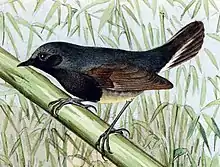Blackthroat
The blackthroat (Calliope obscura), also known as the black-throated robin or black-throated blue robin, is a species of bird in the family Muscicapidae. It breeds in north-central China but its wintering grounds are uncertain. It has been recorded as a vagrant in northwest Thailand. Its natural habitat is bamboo thickets within coniferous forest at altitudes of 3000–3,400 metres. It is threatened by habitat loss.
| Blackthroat | |
|---|---|
 | |
| Male, drawn by Gustav Mützel, 1891 | |
| Scientific classification | |
| Domain: | Eukaryota |
| Kingdom: | Animalia |
| Phylum: | Chordata |
| Clade: | Dinosauria |
| Class: | Aves |
| Order: | Passeriformes |
| Family: | Muscicapidae |
| Genus: | Calliope |
| Species: | C. obscura |
| Binomial name | |
| Calliope obscura (Berezowski & Bianchi, 1891) | |
| Synonyms | |
|
Luscinia obscura | |
The species was discovered in 1891, but for the next 120 years only a handful of individuals were seen and to date no female has been conclusively identified. So little was known of it that it earned the title " Asia's most enigmatic robin".[2]
In June 2011 a team of scientists discovered its breeding grounds in the Qinling Mountains, Shaanxi Province, north central China. Seven singing males were seen in Foping and a further seven in Changqing Nature Reserves- almost equal to the total number seen previously.[3]
In 2014 a female and breeding pair were sighted.[4]
The first formal description of the blackthroat was by the Russian ornithologists Valentin Bianchi and Mikhail Berezovski in 1891 who coined the binomial name Larvivora obscura.[5][6] The species was later placed in the genus Luscinia but when a molecular phylogenetic study published in 2010 found that Luscinia was not monophyletic the genus was split and several species including blackthroat were moved to the reinstated genus Calliope.[7][8]
References
- BirdLife International (2020). "Calliope obscura". IUCN Red List of Threatened Species. 2020: e.T22709717A155299424. doi:10.2305/IUCN.UK.2020-3.RLTS.T22709717A155299424.en. Retrieved 11 November 2021.
- Qian, W.; Yi, H. (2011). "First images in the wild of Blackthroat Luscinia obscura, Asia's most enigmatic robin" (PDF). BirdingASIA. 15: 17–19.
- BBC Nature 15/12/2011
- "Rare blackthroated blue robins spotted in China". BBC News. Retrieved 8 April 2014.
- Mayr, Ernst; Paynter, Raymond A. Jr. (1964). Check-list of Birds of the World. Volume 10. Vol. 10. Cambridge, Massachusetts: Museum of Comparative Zoology. p. 45.
- Bianchi, Valentin; Berezowski, Mikhail (1891). Ptitsy gansuiskago puteshestviia G. N. Potanina 1884-1887 [The birds of the Gansu expedition of G.N. Potanin 1884–1887] (in Russian). Saint Petersburg: Tip. I. Akademii nauk. p. 97.
- Sangster, G.; Alström, P.; Forsmark, E.; Olsson, U. (2010). "Multi-locus phylogenetic analysis of Old World chats and flycatchers reveals extensive paraphyly at family, subfamily and genus level (Aves: Muscicapidae)". Molecular Phylogenetics and Evolution. 57 (1): 380–392. doi:10.1016/j.ympev.2010.07.008. PMID 20656044.
- Gill, Frank; Donsker, David, eds. (2016). "Chats, Old World flycatchers". World Bird List Version 6.2. International Ornithologists' Union. Retrieved 20 May 2016.
Further reading
- Alström, P.; Song, G.; Zhang, R.; Gao, X.; Holt, P.I.; Olsson, U.; Lei, F. (2013). "Taxonomic status of Blackthroat Calliope obscura and Firethroat C. pectardens". Forktail. 29: 94–99.
- Song, G.; Alström, P.; Zhang, R.; Gao, X.; Gong, H.; Holt, P.I.; Quan, Q.; Yin, Z.; Lei, F. (2014). "Rediscovery of an enigmatic Chinese passerine, the Blackthroat Calliope obscura: plumage, vocalizations, distribution, habitat choice, nesting and conservation". Journal of Ornithology. 155 (2): 347–356. doi:10.1007/s10336-013-1009-5. S2CID 14257667.
- Round, P.D.; Clement, P. (2015). "Firethroat Calliope pectardens and Blackthroat C. obscura: notes on winter plumages and habitats". BirdingASIA. 23: 84–87.
- Alström, P.; Zhao, M.; He, P.; Lei, F. (2016). "New locality for the endangered Blackthroat Calliope obscura". Journal of Ornithology. 157: 371–372. doi:10.1007/s10336-015-1279-1. S2CID 26763327.
External links
 Data related to Calliope obscura at Wikispecies
Data related to Calliope obscura at Wikispecies Media related to Calliope obscura at Wikimedia Commons
Media related to Calliope obscura at Wikimedia Commons- Xeno-canto: Sound recordings
